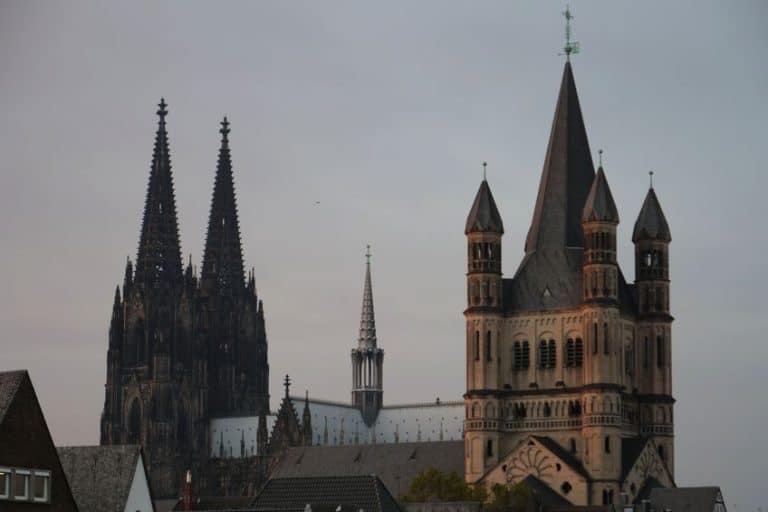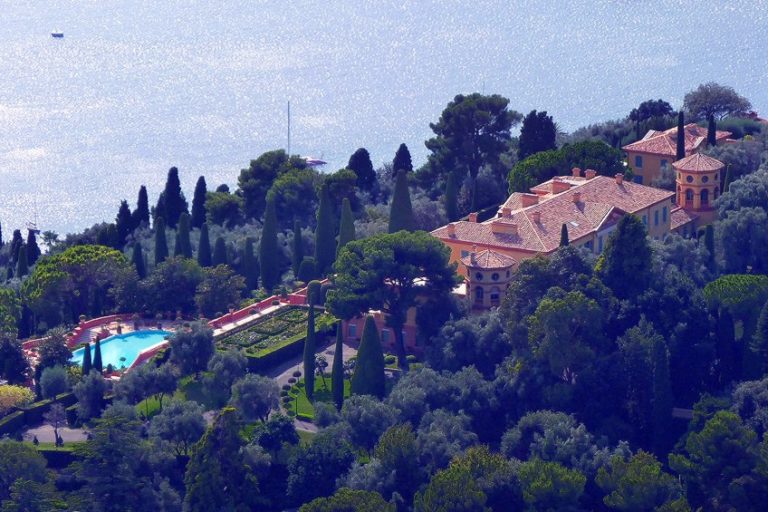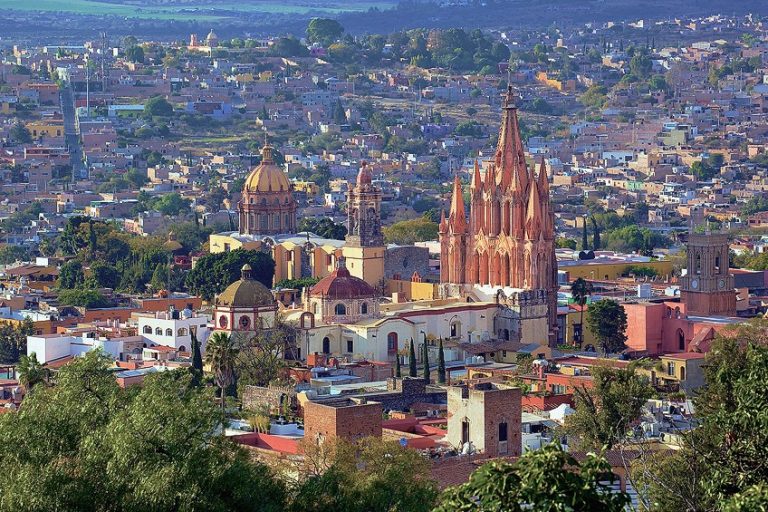Famous Megaliths – The Mysteries of Ancient Megastructures
What are megaliths and what is megalithic architecture? Ancient tribes created stone megaliths without the use of cement or mortar. In principle, these famous megaliths exclude structures produced by established civilizations such as the Maya or Romans but instead refer to megalithic architecture constructed by more ancient cultures. Let’s take a look at some of the most well-known megalithic structures around the world.
An Introduction to Megalithic Architecture
Stone megaliths are one of the most remarkable categories of archaeological monuments. One of the reasons they are so popular is that they are common throughout Western Europe, the cradle of modern science. Many great minds must have been captivated as children by these exotic deviations to rural life: fabled stones placed by an old unknown race with no apparent practical utility. People have always enjoyed straining their imaginations to discover a reasonable explanation for the various mysteries provided by megalithic structures around the world. Scholars have also long grappled with the question of how ancient peoples were able to create these megastructures.

Even now, we may accept that there are hundreds of mysteries for us to still solve. Many undiscovered and forgotten megaliths could possibly be located in areas where megaliths have not yet been recorded.
Although the majority of megaliths in the world date from between the Mesolithic and Bronze Ages, there are some exceptional cases, such as Iron Age stone vessels in Sweden, medieval mazes and labyrinths, and other famous megaliths on several Indonesian islands that are still in use today.
There are also other monuments created without stones in this category, such as peaty earth labyrinths in Northern Europe. Ancient tombs are frequently megaliths. Stone ships and passage burials are examples of these. Many megalithic structures around the world are the locations of ancient or even modern cults. Megaliths are frequently ancient fortresses. There are also other intriguing examples of megalithic architecture with unknown significance or uses.
Famous Megaliths
Famous megaliths comprise a wide range of monuments. Initially, the word “megalith” was given to Western European monuments, and a categorization system with several local variants was devised. However, the large number and variety of megaliths found outside of Europe make this categorization considerably more difficult. Here are the most well-known megalithic structures around the world.
Göbekli Tepe (Turkey) – c. 9,500 BCE
| Architect | Unknown |
| Period | c. 9,500 BCE |
| Function | Settlement |
| Location | Örencik, Turkey |
Klaus Schmidt discovered large engraved stones around 11,000 years old, sculpted and organized by prehistoric humans who had not yet mastered tools and weapons or even earthenware, six miles from Urfa, an ancient city in southern Turkey. Stonehenge was built 6,000 years after these megaliths. The site is known as Gobekli Tepe, and the German archaeologist who has been analyzing the area for almost a decade thinks it is the location of the oldest temple in the world.
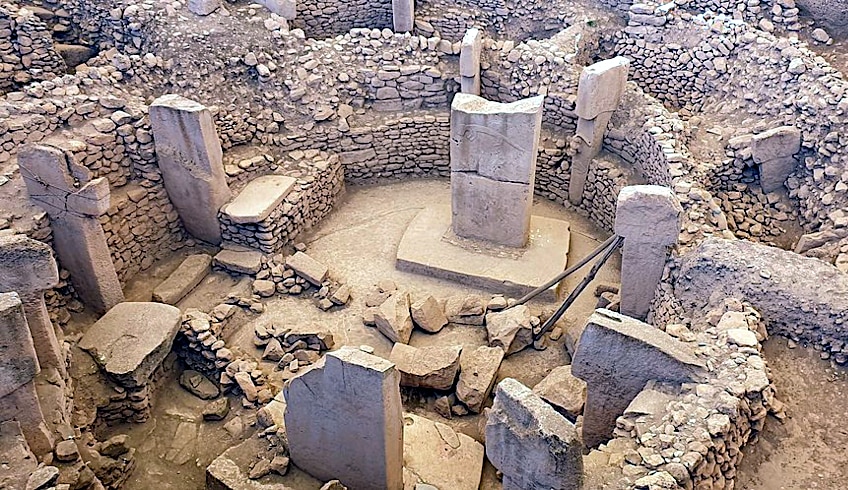
Gobekli Tepe is situated on the northern fringe of the Fertile Crescent, which stretches from the Persian Gulf to present-day Israel, Lebanon, Jordan, and Egypt, and would have drawn hunter-gatherers from the Levant and Africa.
Because archeologists have uncovered no indication that humans lived continuously on the peak of Gobekli Tepe, they assume this was a massive place of worship. In the 1960s, anthropologists from Istanbul University and the University of Chicago investigated – and disregarded – Gobekli Tepe. They visited the hill as part of a wide study of the area, found some fractured slabs of limestone, and concluded the hill was nothing more than an ancient medieval graveyard.
Dolmen of Menga (Antequera, Málaga, Spain) – 3,750 BCE
| Architect | Unknown |
| Period | c. 3,750 BCE |
| Function | Burial mound |
| Location | Antequera, Málaga, Spain |
The Dolmen of Menga is a tumulus, or long barrow, type of megalithic burial mound. It is one of Europe’s biggest recorded megalithic structures. It was constructed of 32 megaliths, the biggest weighing around 200 tons. The existence of a narrow and deep well at the chamber’s bottom is a highly unusual peculiarity among megalithic architecture. It depicts a sequence of anthropomorphic carvings in the shape of a cross and a star on the first orthostat of the hallway.
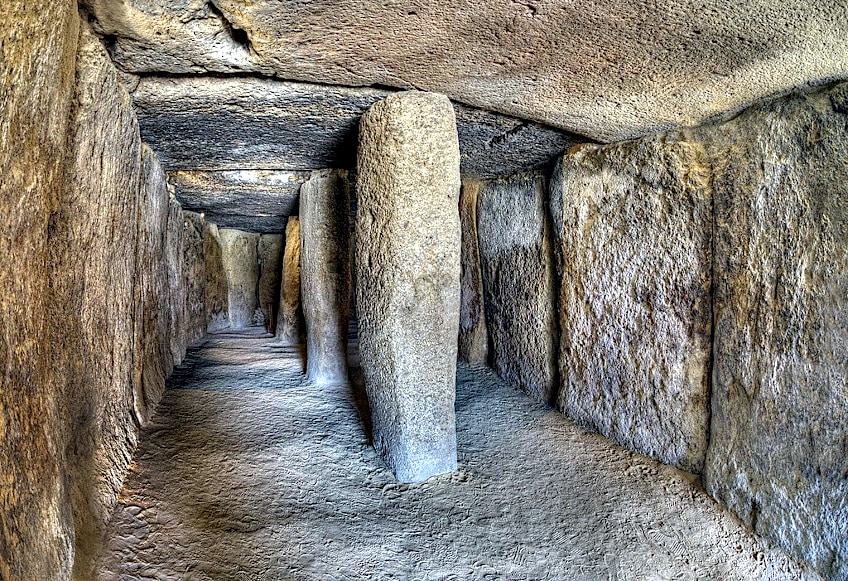
The Antequera Megalithic Complex’s surroundings are unusually rich in both abiotic and biotic resources.
Flint was a valuable mineral resource during the Neolithic and Copper Ages when the Antequera megaliths were constructed. The detrital rocks utilized in the building of Menga Dolmen came from within 500 meters of the Antequera dolmens. The recent excavations within the dolmen reveal the possibility of one or more orthostats in the atrium, as well as one extra pillar. This pillar would have been positioned between the back of the hall and the front of the antechamber and would have been oriented with the previously stated ones.
https://www.youtube.com/watch?v=-dZg2fvbZSE
Megalithic Temples of Malta (Malta) – c. 3,600 BCE
| Architect | Unknown |
| Period | c. 3,600 BCE |
| Function | Temple |
| Location | Valletta, Malta |
Several of the stone slabs at the temples of Malta have circular holes in them at various spots. It is supposed that these were oracle stones. According to the belief, devotees or worshipers would be on one side, while a religious prophet would have been on the other. After that, a prophecy or blessing would have been provided. A number of figures were discovered surrounding the site and are currently on exhibit at the Archaeology Museum of Malta in Valletta. The most well-known are the Venus figurines. The island of Gozo is home to the Ggantija temples.
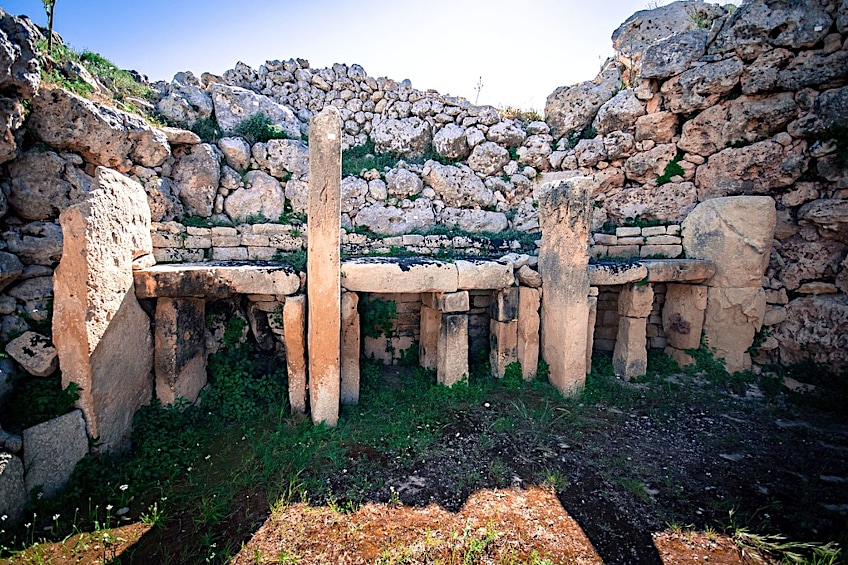
They are the earliest of Malta’s megalithic temples, with the first building phases dating from 3600 to 3000 BCE. Humans will never know who erected these megalithic structures since the builders left no historical evidence. Until the discovery of Göbekli Tepe, they were thought to be the oldest freestanding buildings on Earth. The Tarxien Temple complex is also located in Malta. As with the other megalithic temples, no one knows who built the temples or what their ultimate function was.
Because of the animal reliefs and the abundance of animal bones, one interpretation holds that they were a site for animal sacrifices.
Newgrange (Ireland) – c. 3,200 BCE
| Architect | Unknown |
| Period | c. 3,200 BCE |
| Function | Religious |
| Location | County Meath, Ireland |
Newgrange is in the Irish county of Meath. It is an incredibly beautiful Neolithic passage tomb created approximately 3,200 BCE, making it older than the Egyptian pyramids or Stonehenge. A massive round mound with an internal stone tunnel and chambers makes up the site. Human bones, burial goods, or votive gifts, were unearthed in these vaults. Many of Newgrange’s bigger stones are covered in megalithic artwork. A 19-meter tunnel leads into a room with three alcoves.
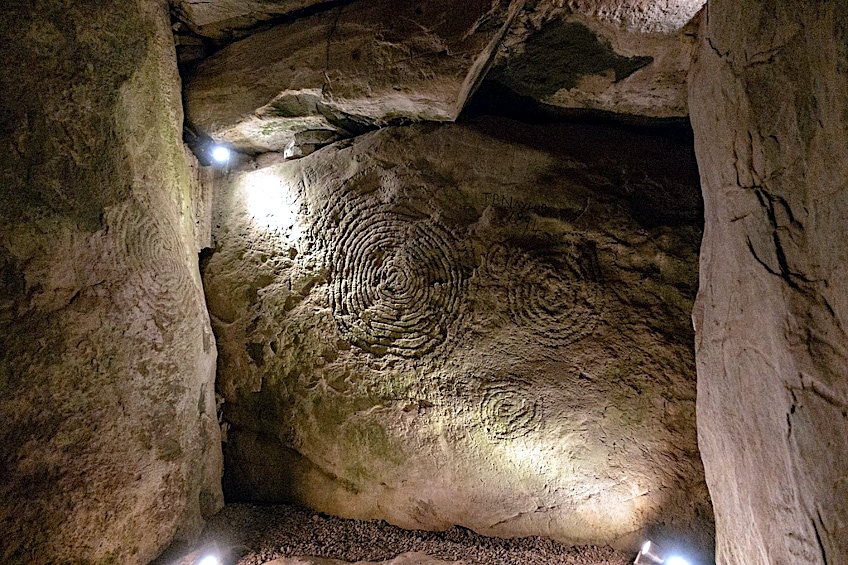
On days around the Winter Solstice, the tunnel and hall are oriented with the rising sun.
Over 100 large stones, or kerbstones, surround Newgrange, with the entrance stone being the most notable. Newgrange was once classified by archaeologists as a passage tomb, although it is now understood to be much more than that. A more accurate description would be that of an ancient temple, a place of religious, ceremonial, and astrological significance, similar to how current cathedrals are places of distinction where nobles may be buried. The Bru Na Bóinne cluster of monuments, which were built around a Boyne River bend, includes Newgrange.
Stonehenge (England) – c. 3,000 BCE
| Architect | Unknown |
| Period | c. 3,000 BCE |
| Function | Burial ground, astronomical observatory |
| Location | Wiltshire, England |
For millennia, academics and archaeologists have pondered over the numerous secrets of Stonehenge, the prehistoric structure that took an astonishing 1,500 years to create by Neolithic craftsmen. It is situated in southern England and is made up of around 100 enormous upright stones arranged in a circular pattern.
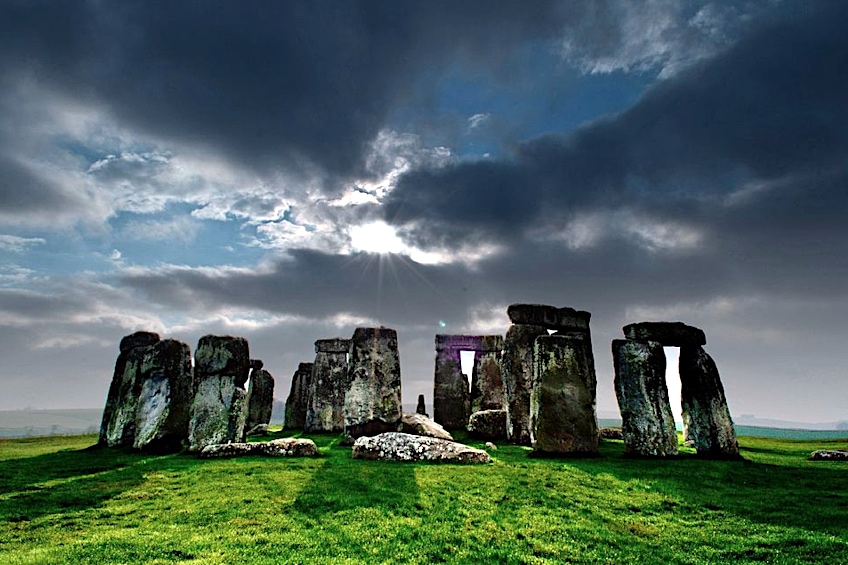
While many historians today now believe that Stonehenge was originally a burial site, they have failed to conclusively discern what other functions it performed and how a culture lacking modern technology created the colossal structure.
Its creation is all the more perplexing since, whereas the sandstone blocks of its outer circle come from nearby sources, the bluestones that constitute its inner circle have been tracked all the way back to the Preseli Hills, approximately 200 miles from Stonehenge in Wales. The sarsens at Stonehenge, the biggest of which tips the scales at more than 40 tons, were most likely obtained from quarry sites 25 miles to the north of Salisbury Plain and moved using sleds and cords; they could have even been scattered nearby when the monument’s Neolithic designers first began construction there.
Dolmens of Marayoor (Kerala, India) – 3,000 BCE
| Architect | Unknown |
| Period | 3,000 BCE |
| Function | Tombs |
| Location | Kerala, India |
The Marayoor Munnar Dolmens are located in Kerala, India. The dolmens are known as “muniyara” in the local language, which means “sadhus’ refuge”. According to archaeological investigations, these constructions date back to the stone era. There is further speculation that they were tombs created thousands of years ago. The majority of them are constructed with four rock slabs, three for the sides and a third for the roof. Dozens of Dolmens in the region of the old Shiva shrine at Kovilkadavu on the banks of the River Pambar, as well as rock art on the south-western slopes of the hill opposite the river, have drawn visitors.

Apart from Stone Age dolmens, other Iron Age dolmens remain in this location, particularly on the left bank of the Pambar River, as shown by the use of well-processed stone blocks for the dolmens.
Rujm el-Hiri (Golan) – 2,700 BCE
| Architect | Unknown |
| Period | c. 2,700 BCE |
| Function | Burial ground, astronomical observatory |
| Location | Wiltshire, England |
Rujm el-Hiri is an ancient megalithic structure composed of concentric stone rings with a tumulus in the center. It is situated in the Israeli-occupied Golan, some 16 kilometers east of the Sea of Galilee’s coast, in the center of a huge plateau filled with hundreds of dolmens. It comprises over 42,000 basalt boulders placed in concentric circles, with a 4.6-meter-tall mound in the center. Some circles are completed, whereas others are not.
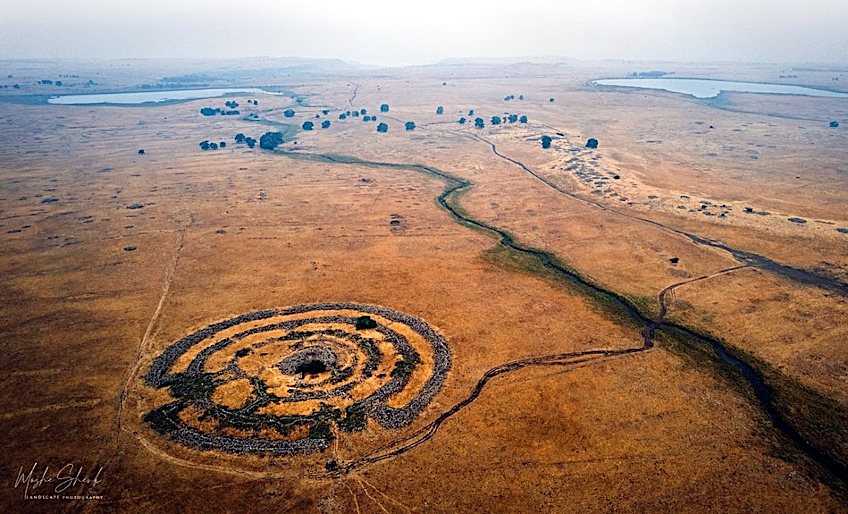
The outer wall is 160 meters in circumference and stands 2.4 meters tall. Archaeologists date the founding of the site and other neighboring ancient villages to the Early Bronze Age II era. Due to the scarcity of material remains, Israeli archeologists, believe the site was neither a military position nor a residential sector, but rather a ritual center with traditional rituals to appease the gods, or potentially tied to the worship of the dead. Nevertheless, there is no agreement on its purpose because no such construction has been discovered in the Near East.
Great Dolmen of Zambujeiro (Portugal) – 3,000 BCE
| Architect | Unknown |
| Period | c. 3,000 BCE |
| Function | Burial site, religious function |
| Location | Évora, Alentejo Central, Alentejo, Portugal |
The city of Évora is bordered by significant prehistoric monuments, the most notable of which is this one. It’s a dolmen that stands more than seven meters above the ground and was created around 6,000 years ago as a burial site and for religious purposes. Seven massive stones were used to build a polygonal construction with a 12m-long corridor that was covered in soil and stones to resemble a tiny hill.
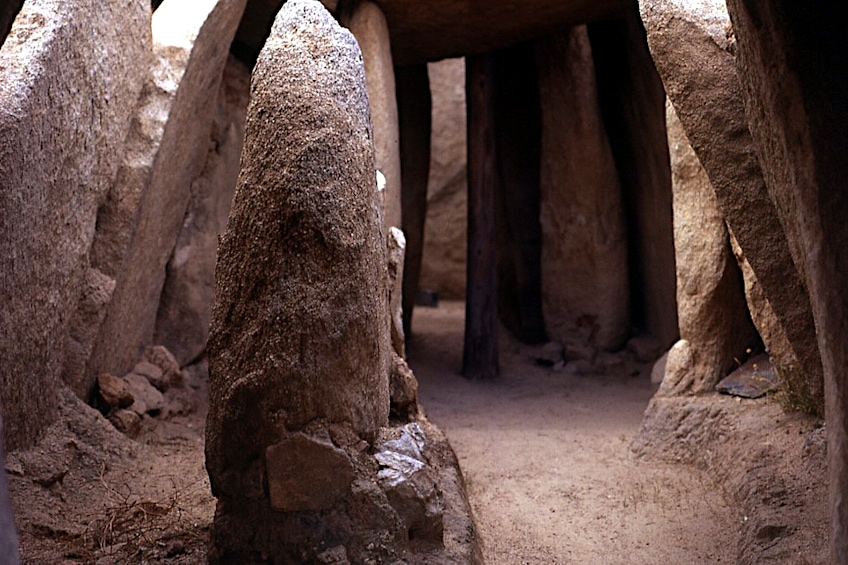
These sorts of structures, which are older than Egypt’s great pyramids, were popular throughout Western Europe, notably in Britain, France, and Portugal, and this is among the biggest still intact on the continent. Some objects, like jewelry and weapons, were discovered during excavations on the site and are now on display at the Évora Museum. It has been designated as a National Monument and is currently protected by a fence.
Castlerigg Stone Circle (North West England) – 2,500 BCE
| Architect | Unknown |
| Period | 2,500 BCE |
| Function | Trading place for axes |
| Location | Karyamukti, Cempaka, Cianjur Regency, West Java, Indonesia |
Several archaeologists have praised Castlerigg and the adjacent scenery for its beauty and romanticism. Archaeologist John Waterhouse said in his analysis of Cumbria’s stone circles that the location was “one of the most aesthetically spectacular ancient structures in Britain”. Thousands of people visit the monument each year, making it the most popular stone circle in Cumbria.

This plateau is the elevated center of a natural amphitheater formed by the encircling fells, and from inside the circle, you can see some of Cumbria’s tallest peaks, including Skiddaw, Helvellyn, Grasmoor, and Blencathra.
It is said that counting the number of stones in Castlerigg is difficult; as each effort yields a different answer. Nevertheless, this legend may not be far from reality. Because of the enormous number of visitors to the monument, the earth around the stones has eroded, and numerous tiny stones have emerged adjacent to some of the bigger stones. Since these stones are so little, they are most likely packing stones used to sustain the bigger stones when the stone circle was built and would have been buried at the time.
Gunung Padang (Indonesia) – (Undetermined Date)
| Architect | Unknown |
| Period | Undetermined date |
| Function | Settlement |
| Location | Karyamukti, Cempaka, Cianjur Regency, West Java, Indonesia |
Gunung Padang, located in Indonesia’s West Java region, is regarded as Southeast Asia’s biggest and most mysterious megalithic structure. It is located in the town of Karyamukti, some 30 kilometers from Cianjur, and comprises a succession of rectangular stone fortifications with inner partitions, pathways, and gate entries, as well as many wrecked rock mounds. They are made of andesite, which forms naturally. The numerous constructions are spread across five distinct terraces or courtyards, which are joined by climbing staircases defined by standing pillars.
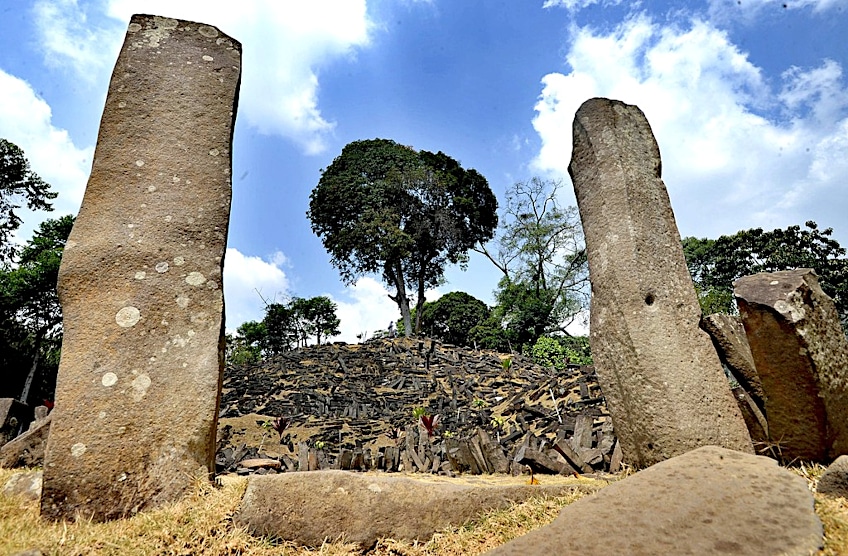
These terraces ascend in stages to over 960 meters above sea level and span an area of around 900 square meters. The courtyards are reached from the north-northwest through a 370-step rising stairway that rises at a nearly 45 degree angle. This begins in the valley below and rises around 90 meters from its base to the topmost terrace. Each terrace is built one on top of the other atop a volcanic hill formation that faces north-northwest.
Geologists have proposed that the volcano is the origin of the andesite pillars used to form the stone settings, a claim that has since been challenged in light of new finds.
A megalith is a massive, generally naked stone that was used to build numerous Neolithic, Chalcolithic, or Bronze Age structures. Although these monuments can be made of a single stone, most megalithic monuments are made up of many stones that are joined together without the use of cement or mortar. This sort of rock art was utilized in ritualistic or ceremonial constructions, single or numerous tombs, and sanctuaries.
Take a look at our famous megaliths webstory here!
Frequently Asked Questions
What Are Megaliths?
The doorway tomb, often known as the dolmen, is the most frequent kind of megalithic building. This was normally made up of multiple upright supports that were capped with a flat roofing stone. Most entrance tombs were protected by an earthen mound, which has already faded away in many cases. Dolmens were the first kind of cyclopean stone burial, from which two more types arose: the passage tomb and the gallery grave.
Why Were Megaliths Built?
The exact significance of megalithic architecture, construction, and ornamental art is unknown. Many of them appear to have had considerable significance, not least due to the immense effort needed in their creation, as well as the existence of numerous carvings and other forms of megalithic artwork. It is also worth mentioning that the groups that constructed these megalithic structures must have followed a similar design.
Justin van Huyssteen is a freelance writer, novelist, and academic originally from Cape Town, South Africa. At present, he has a bachelor’s degree in English and literary theory and an honor’s degree in literary theory. He is currently working towards his master’s degree in literary theory with a focus on animal studies, critical theory, and semiotics within literature. As a novelist and freelancer, he often writes under the pen name L.C. Lupus.
Justin’s preferred literary movements include modern and postmodern literature with literary fiction and genre fiction like sci-fi, post-apocalyptic, and horror being of particular interest. His academia extends to his interest in prose and narratology. He enjoys analyzing a variety of mediums through a literary lens, such as graphic novels, film, and video games.
Justin is working for artincontext.org as an author and content writer since 2022. He is responsible for all blog posts about architecture, literature and poetry.
Learn more about Justin van Huyssteen and the Art in Context Team.
Cite this Article
Justin, van Huyssteen, “Famous Megaliths – The Mysteries of Ancient Megastructures.” Art in Context. January 3, 2023. URL: https://artincontext.org/famous-megaliths/
van Huyssteen, J. (2023, 3 January). Famous Megaliths – The Mysteries of Ancient Megastructures. Art in Context. https://artincontext.org/famous-megaliths/
van Huyssteen, Justin. “Famous Megaliths – The Mysteries of Ancient Megastructures.” Art in Context, January 3, 2023. https://artincontext.org/famous-megaliths/.







